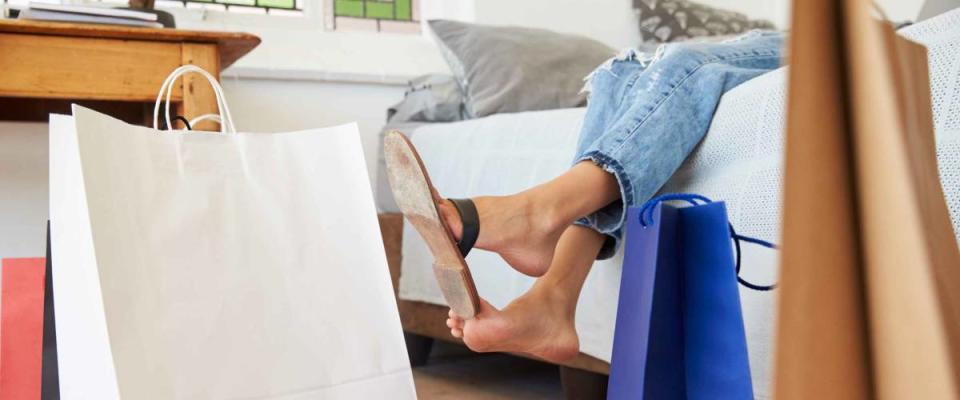'Buy now, pay later' plans are all the rage — here's how they work

Got your eye on a stylish new jacket and some for the summer months? Why pay for it now when you can pay later, in installments?
Buy Now, Pay Later (BNPL) services are gaining traction, as Americans are still feeling the financial pinch from the pandemic. By splitting up your payments, you can keep buying things as you normally do, even if you’re light on cash.
Sound pretty good? Here are some pros and not-so-obvious cons of buying now and paying later, plus a few alternatives that might save you more money.
How does Buy Now, Pay Later work?

Remember putting things on layaway? Maybe not — the practice that became popular during the Great Depression has mostly gone out of style as more shoppers opt for credit cards (and rack up credit card debt). In 2006, Walmart ended its layaway program after 44 years.
Layaway allows cash-strapped shoppers to place an item on hold while they make payments, then bring it home once they’ve paid in full. But with BNPL, you can bring the item home immediately.
To buy now and pay later, you first need to create an account with a third party. You have a few choices, including Klarna, Afterpay, Sezzle, Affirm, QuadPay and more.
The typical list of criteria is short: be at least 18 years old and have a valid debit or credit card to link to the account. Some companies will run a credit check to get a look at your basic financial history before they determine how much you should be allowed to finance.
Once you’re signed up, you can BNPL at any of the stores associated with that service.
In most cases, these installment plans are interest-free. You’ll pay extra only if you can’t make the payments on time.
Who’s using Buy Now, Pay Later?

Given the ongoing retail apocalypse of massive store closings, merchants are desperate for anything that will attract more customers.
BNPL could do just that, especially for young shoppers. A report from PYMNTS.com says 87% of consumers ages 22 to 44 are interested in monthly installment plans.
And the economic turbulence from COVID has helped spark more interest. Afterpay says it tripled its user base by June 2020, compared to just a year earlier.
What are the upsides?

In some cases, BNPL can prove to be a worthwhile option to those that need it.
Fitting a purchase into your budget: Spacing out your payments can alleviate the strain on your bank account. Some BNPL companies run on a biweekly payment schedule, which could line up well with your paycheck. Ideally, you should try to save up for a purchase, but BNPL could help you snag the perfect outfit for a job interview if you’re still a week from pay day.
Flexibility without a credit card: Though you can get certain credit cards without a stellar credit score, some of those cards require a security deposit, which you might not be able to afford. Without a credit card, BNPL may be your only option for certain purchases.
Skipping credit card fees: If you’re already paying high interest on your credit card balance, you should consider refinancing or consolidating that debt first. Otherwise, these services can help you make a purchase without adding to your credit card balance, which can have APRs between 14% and 24%. But remember: This only works if you can stay on top of your repayment plan.
Earning rewards: Some BNPL companies offer exclusive discounts and features. Klarna, for example, will notify you if an item you’re watching drops in price. Other companies are experimenting with loyalty programs, where shoppers can earn rewards by using the service.
What are the pitfalls?

Like other forms of credit, BNPL bills can come back to haunt you if you don’t plan ahead.
Expensive late fees: If you can’t make your installments, the fees can start to add up. The amount will depend on the service. Afterpay will charge you the lesser of 25% of the purchase price or $24. Klarna can charge you a total of $21 after three consecutive late payments.
High interest rates: Not all BNPL companies offer a zero interest rate. Affirm doesn’t charge late fees but can charge interest of up to 30% depending on the plan — much higher than the average credit card interest of 16.43%. And if your BNPL plan is linked to your credit card, payments will simply add to your card balance at a high APR.
Spending money you don’t have: These services, much like credit cards, can encourage impulse buying. If you can’t afford those fancy shoes now, will things really be different in the weeks to come?
Hurting your credit score: Some of these companies will do hard credit checks, which can temporarily ding your credit score. They also might report your missed or late payments to the credit bureaus, further weakening your score. And to top if off, these services may not help you build your score if regular payment activity isn’t reported to the bureaus.
Other ways to afford your next shopping spree

If you can save money and wait patiently before indulging in retail therapy, your future self will thank you.
Here are some essential strategies to conserve coin and avoid potential debt traps:
Freeze other bills. Because of the pandemic, some companies have let customers put their payments on hold. While it might not make financial sense to defer payments in favor of the newest gadget, you could put those savings towards your current debt.
Get a better insurance rate. You could be saving $1,000 a year or more just by getting a better rate on your homeowners insurance — and you could trim your auto insurance even more. Feel free to put those savings directly toward your clothing budget.
Refinance your mortgage. If you have a mortgage and haven’t refinanced lately, it’s time to look into it. Thanks to historically low mortgage rates, more than 19 million homeowners have the potential to cut their monthly payments by around $300, says data firm Black Knight.
Find discounts online. You might be able to pay for that jacket now if it was a bit cheaper. Download a free browser extension that works while you're shopping to search through thousands of other sellers to find a better price.
Pick up a side hustle. The best way to afford your shopping trips is by increasing your income. You can try to negotiate a raise, or you can build your own side gig to earn hundreds or thousands extra.

 Yahoo Finance
Yahoo Finance 